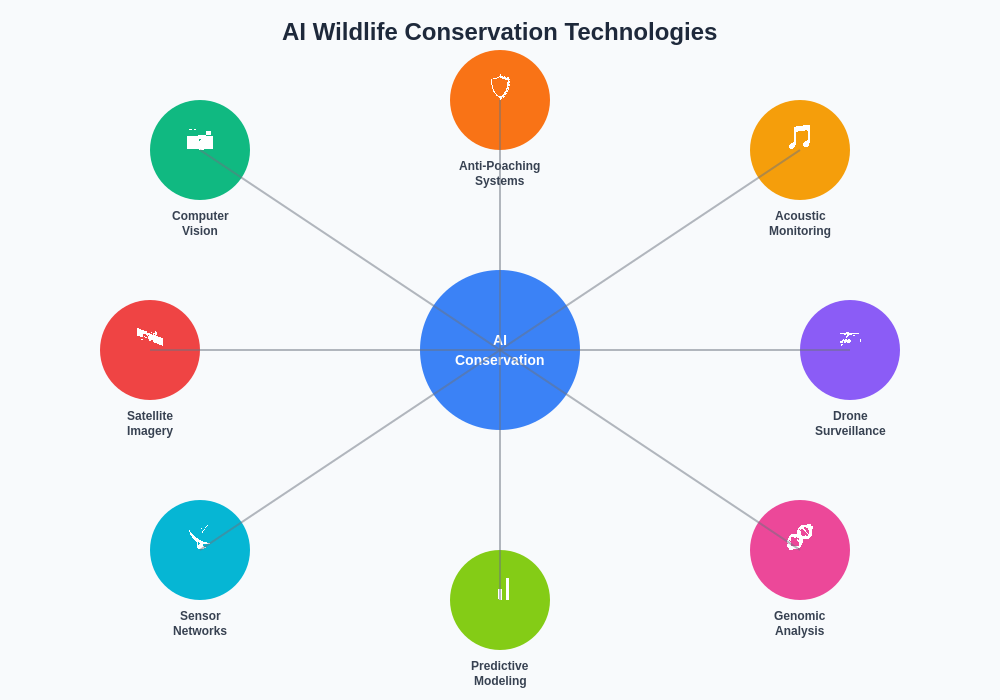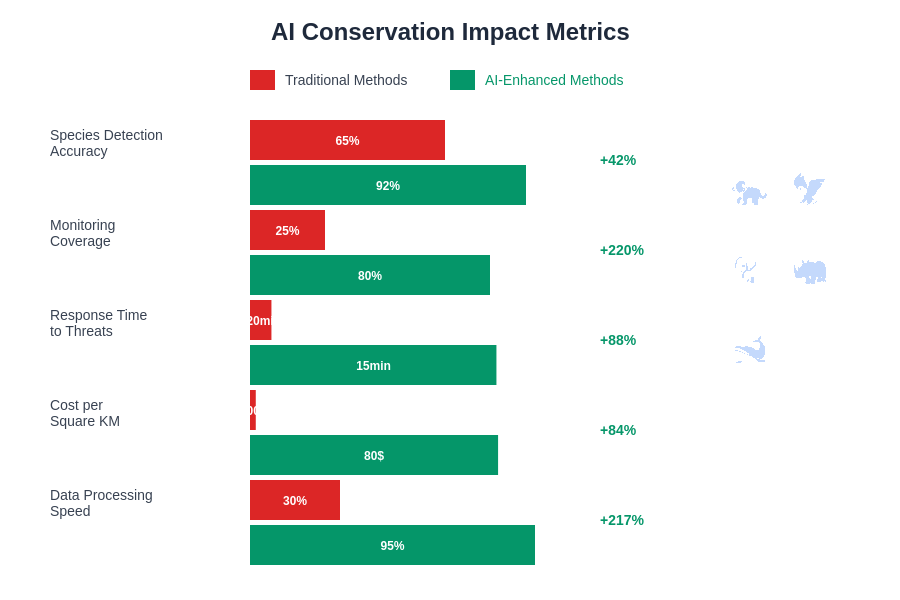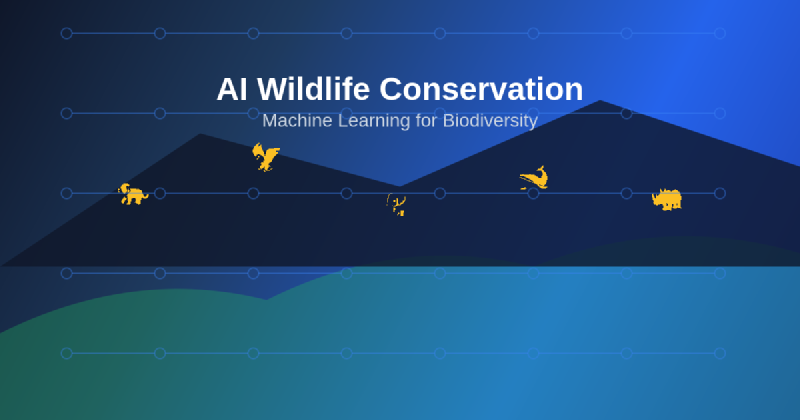The intersection of artificial intelligence and wildlife conservation represents one of the most promising applications of modern technology in addressing the global biodiversity crisis. As ecosystems worldwide face unprecedented threats from climate change, habitat destruction, and human encroachment, conservation scientists and researchers are increasingly turning to machine learning algorithms, computer vision systems, and advanced data analytics to monitor, protect, and preserve the planet’s precious wildlife populations. This technological revolution in conservation science is transforming how we understand animal behavior, track endangered species, and implement effective protection strategies across diverse ecosystems.
Explore the latest AI breakthroughs in conservation to stay informed about cutting-edge technologies that are making significant impacts in wildlife protection and environmental monitoring. The convergence of artificial intelligence with conservation biology has opened new frontiers in our ability to safeguard biodiversity and ensure the survival of threatened species for future generations.
The Digital Revolution in Conservation Science
The traditional methods of wildlife monitoring and conservation research have long relied on manual observation, physical tracking devices, and labor-intensive field studies that often provided limited data coverage and required substantial human resources. The integration of artificial intelligence into conservation practices has fundamentally transformed these approaches by enabling automated monitoring systems, real-time data analysis, and comprehensive ecosystem surveillance that operates continuously across vast geographical areas. Machine learning algorithms can now process enormous datasets from camera traps, acoustic sensors, satellite imagery, and environmental monitoring stations to provide unprecedented insights into wildlife populations, migration patterns, and ecosystem health indicators.
This digital transformation has democratized conservation research by making sophisticated monitoring technologies accessible to smaller organizations and enabling global collaboration through shared data platforms and standardized analytical frameworks. The ability to deploy AI-powered conservation tools in remote and challenging environments has expanded our monitoring capabilities to previously inaccessible regions, providing critical data for species that were historically difficult to study and protect effectively.
Computer Vision for Wildlife Identification and Monitoring
One of the most significant breakthroughs in AI-powered conservation has been the development of sophisticated computer vision systems capable of automatically identifying and tracking individual animals across different environments and conditions. These systems utilize deep learning neural networks trained on vast databases of wildlife images to recognize species, count populations, and even identify individual animals based on unique physical characteristics such as stripe patterns, facial features, or distinctive markings. The accuracy and efficiency of these identification systems have reached levels that often surpass human observers, particularly in challenging conditions such as low light, dense vegetation, or when dealing with cryptic species that are naturally difficult to spot.
Discover advanced AI capabilities with Claude to explore how machine learning models can be developed and deployed for specialized conservation applications. The implementation of computer vision technology in camera trap networks has revolutionized wildlife monitoring by enabling continuous surveillance of animal populations without human presence, reducing disturbance to natural behaviors while providing comprehensive data on species distribution, abundance, and activity patterns.
Acoustic Monitoring and Bioacoustic Analysis
The application of machine learning to acoustic monitoring represents another transformative approach in wildlife conservation, particularly for species that are more easily detected through their vocalizations than visual observation. Advanced audio processing algorithms can automatically identify and classify animal calls, songs, and other acoustic signatures from continuous audio recordings collected in natural habitats. These bioacoustic monitoring systems are especially valuable for monitoring nocturnal species, birds in dense forest canopies, marine mammals, and other animals that are difficult to observe directly but produce distinctive vocalizations.
Machine learning models trained on acoustic data can detect subtle changes in call patterns that might indicate stress, mating behavior, territorial disputes, or responses to environmental changes, providing researchers with detailed insights into animal behavior and ecosystem dynamics. The ability to process months or years of continuous audio recordings automatically has enabled long-term studies of animal communication patterns and population trends that would be impossible to analyze manually.
Predictive Modeling for Habitat Conservation
Artificial intelligence has revolutionized habitat conservation planning through the development of sophisticated predictive models that can forecast habitat suitability, species distribution changes, and the potential impacts of environmental modifications on wildlife populations. These models integrate diverse data sources including climate projections, land use changes, human development patterns, and species ecological requirements to identify priority areas for conservation action and predict how different management strategies might affect biodiversity outcomes.
Machine learning algorithms excel at identifying complex patterns and relationships within large environmental datasets that might not be apparent through traditional analytical approaches. This capability enables conservation planners to optimize protected area networks, identify wildlife corridors that facilitate species movement between fragmented habitats, and anticipate how climate change might affect species distributions over time. The predictive power of these models supports evidence-based decision-making in conservation planning and helps allocate limited conservation resources most effectively.
Anti-Poaching Technology and Wildlife Protection
The fight against wildlife poaching and illegal hunting has been significantly enhanced through the deployment of AI-powered surveillance and detection systems that can identify suspicious activities and alert rangers to potential threats in real-time. These systems combine thermal imaging, motion detection, acoustic analysis, and predictive analytics to monitor protected areas continuously and identify patterns of illegal activity. Machine learning algorithms can distinguish between normal wildlife movement and human intrusion, automatically triggering alerts when potential poaching activities are detected.
Enhance your research capabilities with Perplexity for comprehensive analysis of conservation strategies and anti-poaching technologies being implemented worldwide. The integration of drone technology with AI-powered image analysis has created aerial surveillance systems capable of covering vast areas efficiently while providing detailed intelligence on both wildlife populations and potential security threats.
Marine Conservation and Ocean Monitoring
The application of artificial intelligence to marine conservation presents unique challenges and opportunities due to the vast scale and complexity of ocean ecosystems. Underwater camera systems equipped with AI-powered species identification capabilities can monitor coral reef health, track fish populations, and detect invasive species in marine protected areas. Satellite imagery analysis using machine learning algorithms can identify illegal fishing activities, monitor shipping traffic impacts on marine life, and track large-scale environmental changes such as coral bleaching events or harmful algal blooms.
Acoustic monitoring systems deployed in marine environments can track whale migrations, detect ship noise pollution, and monitor the health of marine ecosystems through the analysis of underwater soundscapes. The ability to process vast amounts of oceanographic data automatically has enabled researchers to study marine ecosystem dynamics at unprecedented scales and develop more effective strategies for protecting ocean biodiversity.
Conservation Genomics and Population Analysis
The integration of artificial intelligence with conservation genomics has opened new possibilities for understanding population genetics, breeding patterns, and evolutionary processes in wild animal populations. Machine learning algorithms can analyze genetic data to identify population bottlenecks, assess genetic diversity, and predict the long-term viability of small populations. These insights are crucial for developing effective breeding programs, managing genetic diversity in captive populations, and making informed decisions about wildlife translocations and reintroductions.
AI-powered analysis of genetic data can also help identify distinct populations or subspecies that require separate conservation strategies, detect hybridization events that might affect species integrity, and track the genetic health of populations over time. The ability to process complex genomic datasets efficiently has made population genetic analysis more accessible to conservation practitioners and enhanced our understanding of the genetic factors that influence species survival and adaptation.
Climate Change Adaptation and Resilience Planning
Climate change represents one of the greatest threats to global biodiversity, and artificial intelligence is playing an increasingly important role in helping species and ecosystems adapt to changing environmental conditions. Machine learning models can predict how species distributions might shift in response to changing temperatures, precipitation patterns, and extreme weather events, enabling proactive conservation planning that anticipates future challenges rather than merely responding to current threats.
These predictive capabilities support the development of climate-adapted conservation strategies such as assisted migration programs, the establishment of climate corridors that facilitate species movement to suitable habitats, and the identification of climate refugia where species might persist during periods of environmental stress. The integration of climate projections with species ecological requirements and habitat connectivity models provides a comprehensive framework for building resilience into conservation planning processes.

The technological ecosystem supporting AI-powered wildlife conservation encompasses a diverse array of interconnected systems and methodologies that work together to provide comprehensive monitoring and protection capabilities. From satellite-based monitoring systems to ground-level sensor networks, these technologies create a multi-layered approach to conservation that maximizes coverage while minimizing environmental impact and operational costs.
Citizen Science and Community Engagement
Artificial intelligence has enhanced the effectiveness of citizen science initiatives by enabling automated quality control of crowd-sourced data and expanding the opportunities for public participation in conservation research. Machine learning algorithms can validate species identifications submitted by citizen scientists, correct common misidentifications, and integrate amateur observations with professional research datasets. This democratization of conservation research has significantly expanded the scale and scope of wildlife monitoring efforts while fostering greater public engagement with conservation issues.
Mobile applications powered by AI technology enable citizens to contribute high-quality data to conservation projects simply by photographing wildlife or recording animal sounds during outdoor activities. These contributions aggregate into valuable datasets that inform conservation decisions and help track species populations across broad geographical areas that would be impossible to monitor through professional research efforts alone.
Data Integration and Ecosystem Modeling
The true power of AI in wildlife conservation emerges through the integration of diverse data sources into comprehensive ecosystem models that capture the complex interactions between species, habitats, and environmental factors. Machine learning algorithms excel at identifying patterns and relationships within these complex datasets, revealing insights that inform holistic conservation strategies rather than species-specific approaches. These integrated models can simulate the potential impacts of different management scenarios, helping conservation practitioners evaluate trade-offs and optimize their interventions for maximum biodiversity benefit.
The development of standardized data sharing platforms and analytical frameworks has facilitated collaboration between research institutions, conservation organizations, and government agencies, creating a global network of conservation data that supports evidence-based decision-making at local, regional, and international scales. This collaborative approach maximizes the value of individual research investments while building comprehensive knowledge bases that benefit the entire conservation community.
Challenges and Limitations in AI Conservation
Despite the tremendous potential of artificial intelligence in wildlife conservation, several challenges and limitations must be addressed to realize the full benefits of these technologies. The development and deployment of AI systems require significant technical expertise and computational resources that may be beyond the reach of smaller conservation organizations, potentially creating disparities in access to advanced conservation tools. Additionally, the accuracy and reliability of AI systems depend heavily on the quality and representativeness of training data, which can be challenging to obtain for rare or secretive species that are often the highest conservation priorities.

The quantitative assessment of AI’s impact on conservation outcomes demonstrates significant improvements across multiple key performance indicators including monitoring efficiency, species detection accuracy, threat response time, and cost-effectiveness compared to traditional conservation approaches. These metrics provide compelling evidence for the continued investment in and development of AI-powered conservation technologies.
Environmental factors such as extreme weather conditions, equipment failures, and the inherent unpredictability of wildlife behavior can affect the performance of automated monitoring systems, requiring robust backup systems and adaptive management strategies. The integration of AI technologies with existing conservation workflows also requires careful planning and training to ensure that conservation practitioners can effectively utilize these tools while maintaining their focus on core conservation objectives.
Future Directions and Emerging Technologies
The future of AI in wildlife conservation promises even more sophisticated applications as emerging technologies such as edge computing, 5G connectivity, and advanced sensor technologies become more accessible and affordable. These developments will enable real-time processing of conservation data in remote locations, reducing latency in threat detection and response while minimizing the infrastructure requirements for deploying AI systems in challenging environments.
The integration of artificial intelligence with other emerging technologies such as biotechnology, nanotechnology, and advanced materials science will create new possibilities for minimally invasive monitoring approaches and innovative conservation interventions. Developments in quantum computing may eventually enable the processing of even more complex ecological models, while advances in robotics could lead to automated conservation interventions such as habitat restoration or direct species protection activities.
Building Sustainable Conservation Technology
The long-term success of AI-powered conservation initiatives depends on building sustainable technology ecosystems that can be maintained and updated over time without requiring continuous infusions of external funding or technical support. This sustainability requires the development of open-source tools and platforms that can be adapted and maintained by local conservation organizations, as well as training programs that build technical capacity within the conservation community.
Partnerships between technology companies, academic institutions, and conservation organizations are essential for ensuring that AI development priorities align with real conservation needs and that resulting technologies are accessible to the organizations and communities that need them most. The democratization of AI technology through education, open-source development, and capacity building initiatives will ultimately determine whether these powerful tools can achieve their full potential for protecting global biodiversity.
The continued evolution of artificial intelligence in wildlife conservation represents a transformative opportunity to address the biodiversity crisis through innovative technological solutions that enhance our ability to monitor, understand, and protect the natural world. As these technologies mature and become more accessible, their integration into conservation practice will become increasingly essential for achieving meaningful biodiversity conservation outcomes in an era of rapid environmental change.
Disclaimer
This article is for informational purposes only and does not constitute professional conservation or technical advice. The views expressed are based on current understanding of AI technologies and their applications in wildlife conservation. Readers should consult with qualified conservation professionals and conduct their own research when implementing AI-powered conservation technologies. The effectiveness of these technologies may vary depending on specific environmental conditions, species requirements, and implementation contexts.
